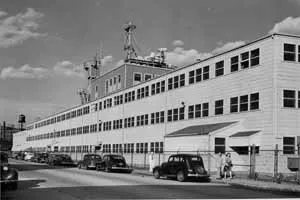During World War II, the until-then introverted and relatively inconsequential United States found itself a warehouse of military production and invention. Engineers and military leaders were trying to build their way out of the war. The advances made during this flurry of manic activity still shape much of everyday American life. Cutting-edge military research – and necessity-driven improvisation – on things like microwave radiation, radar, and military sealants are how we heat office lunches, cast weather forecasts, and repair just about everything (those new military sealants eventually became duct tape).
With 80 years of hindsight, it is easy to imagine noble, ingenious inventors, in white coats and beautiful facilities, devoted to cause and country, with the knowledge the whole world was watching. But if we imagine the innovative work happening around us, does it look anything like that?
So many of these inventions didn’t happen in top-notch labs with the best scientists; they happened in the places where failure seemed like the most obvious option. Many of them happened, specifically, in a cheap, temporary building on MIT’s campus officially known as Building 20, but more commonly known as “the Plywood Palace.”
It was not palatial. The building was meant to last maybe six months after the war but was dark, poorly ventilated, with too narrow of hallways and stairwells to be even remotely comfortable for the number of people working there. The building smelled and began to disintegrate pretty much as soon as it was built. It became a home for the wild, underfunded, experimental laboratories and projects across MIT.
The plywood palace wasn’t like other buildings at MIT. Those who worked there told stories of the very temporariness of the building leading to a chaotic sense of freedom: want to run a cable from this lab to another? Knock a hole in the wall! Want to measure gravitational waves with a massive series of mirrors? Just put them up wherever you can find the space.
Because it was crowded and interdisciplinary, researchers often unintentionally crossed paths and exchanged ideas with those from other fields. Linguists, astrophysicists, and biologists all tripping over and inspiring one another.
The plywood palace was a terrible place to work. It was dark and filled with asbestos and mold; it was falling apart at the seams, and passing trains rattled the whole building, which meant more delicate experiments could only be done in the middle of the night.
And no less than 10 Nobel prizes have been awarded for discoveries made in that building.

Noam Chomsky’s lab was there. Gravitational waves were discovered there. The very beginnings of hacker culture trace their roots there. The first video game may well have been invented there.
What if these incredible breakthroughs weren’t despite the shoddiness of the building but a result of it? Counterintuitively, restraint is often an engine of creativity and innovation, not a hindrance. Discipleship by Design’s Blow Up Your Idea game is rooted in this principle. The idea of the game is that pondering hypothetical (if absurd) restraints, like “How would flying cars impact your idea?” or “Make your idea include fanny packs,” actually unlocks new ways of thinking.
The restraints of lack of resources plus the lack of preciousness that comes from operating in a space that doesn’t assume success allowed researchers to flourish and create some of the most groundbreaking inventions of the twentieth century.
Although Building 20 was demolished in 1998 (a full 45 years past its expiration date), it earned its 10th Nobel in 2017 for work that began in a makeshift lab in the 1970s and, in 2016, proved the existence of gravitational waves, literally being the first device to detect the sounds of the universe.
Maybe it was only in a building made of plywood, with holes drilled in the wall and mirrors hung up with fishing wire, that the absurd concept of listening for the sound of black holes crashing into each other could come alive. Maybe we need space where failure is not only allowed but assumed, and the very walls are disposable so that we can allow the playful, creative, chaotic sides of our most inventive ideas to emerge.
- What are the spaces and seasons where you have been most creative?
- What constraints did you experience? What permissions?
- What would it look like to construct something of a “plywood palace” for yourself, if only in spirit?
- What would it look like to cultivate that spirit for your team?




0 Comments